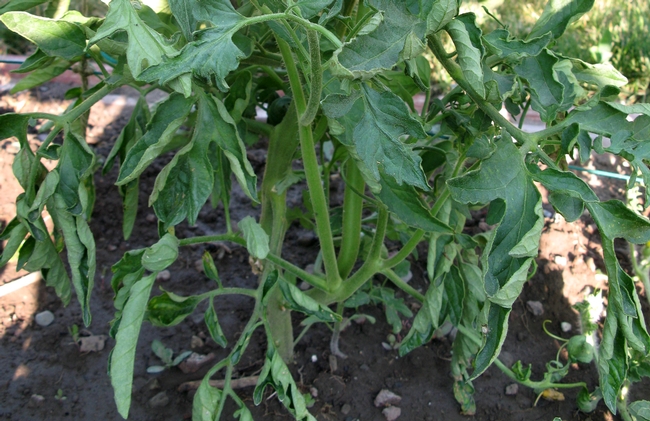Jul 11, 2021
Originally published in the Summer 2021 issue of Utah Pest News.
Many problems that gardeners experience with tomato plants are not related to insect pests or diseases. Rather, they are associated with adverse growing conditions due to the environment or production practices.
- Blossom drop occurs when daytime temperatures exceed 90°F and nighttime temperatures stay above 72°F for several days, causing tomato pollen to become nonviable and blossoms to dry out and drop without producing fruit. Blossom drop can also occur if there is no pollination or temperatures dip below 55°F at night. It can be prevented by setting up shade cloth to protect plants during the hottest periods of the growing season.
- Blossom end rot is the death of tissue on the blossom end of tomato fruits, appearing as dark brown-black target-like rings. It occurs when plants are unable to move enough calcium from the soil throughout the plant, with the tomato being the farthest location and thus getting the least calcium. Blossom end rot can be prevented by evening out the watering to allow the plant to continually uptake water and calcium. Consider using mulch around the plants to prevent water loss.
- Cat-facing is when tomatoes are distorted and misshapen. The damage is caused by one of many factors such as blossom scarring, high nitrogen levels, temperature fluctuations, excessive pruning, or insect feeding. Avoid “cat-faced” fruit by growing cultivars that are less prone to cat-facing (heirloom varieties tend to be more prone). Provide adequate growing conditions and good pest management.
- Cracking and splitting on tomatoes occur when there are rapid changes in soil moisture levels which can cause the fruit to expand quicker than its skin can grow. Openings can leave fruit susceptible to insects and diseases. Prevent this by providing plants with an even watering schedule.
- Cold or freeze damage occurs when tomato plants are exposed to temperatures below 35°F, where plant cells expand, freeze, and die, causing interveinal spots. Leaves on established plants may turn purple and dark. After transplanting, follow weather forecasts closely in the spring and cover plants to protect from any expected frosts.
- Green shoulders appear when tomato fruits are fully ripening, but the top “shoulder” ends remain green and yellow. This is simply caused by genetics and environmental conditions (high temperatures and exposure to direct sunlight).
- Herbicide damage occurs when an broadleaf herbicide contacts the plant directly or indirectly via drift or vapors. Some herbicides that are sprayed in hot temperatures can volatilize and move as a vapor for long distances, affecting vegetable crops. Herbicide damage symptoms include small misshaped leaves that are thick and tightly curled.
- Horn/nose Development is a physiological and genetic disorder. A few cells divide abnormally and the fruit produces an extra locule (interior segment within the tomato). This mutation often occurs in very cool or very hot temperatures during tomato fruiting.
- Edema/oedema is a physiological disorder identified by watery blisters or swellings that form along the leaf veins. It is induced by high relative humidity and light quality. Because of this, edema is most commonly observed in enclosed settings such as greenhouses.
- Leaf curling is associated with various environmental stresses, viral infection, or herbicide damage. Environmental stresses include excessive moisture and nitrogen, heat, drought, severe, pruning, and transplant shock.
 Leaf curling on tomato
Leaf curling on tomato
(Credit: M Murray, USU Extension IPM Program) - Sunscald on tomatoes begins as yellow/brown discoloration on the sun-exposed side of the fruit. Eventually, the flesh becomes tough, white, and leathery. This damage exposes the tomato to potential rot pathogens.
- Zippering is an abiotic condition that occurs when the flower anther sticks to the developing fruit as it grows. Symptoms include a thin brown longitudinal scar (with transverse scars) extending down the fruit, resembling a zipper. Zippered fruits that are intact are still edible; however, openings that ensue can allow pathogen infections or further insect damage.
---
For more on pests and disorders of tomato, see our website for information on managing pests of tomato and horticultural tips for growing tomato.
You can also register for our upcoming webinar on plant diseases Thursday, July 15 at 1:00pm PDT. Attendance is free and open to the public but registration is required. See Urban & Community IPM webinar website for more details.
Topics:

